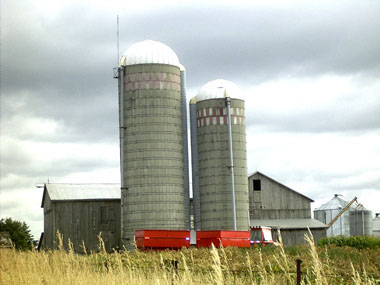Drainage problems are caused by an excess of water at the soil surface or in the root zone. Drainage work is carried out to improve the root-zone environment for crop growth, to improve conditions for cultivation, planting and harvesting, to allow earlier spring planting for better use of the short Canadian growing season, and to convey salts out of the soil in areas where salinity is a problem. The problem of excess water and inadequate drainage is obvious wherever pondings remain after rainfall or snowmelt. A less obvious problem exists when the root zone is saturated but no water is present on the surface. Most crops prefer moist, unsaturated soil, with more than 5% of the root zone volume filled with air. Air space allows roots to respire, grow and obtain nutrients from the soil.
Land drainage work began in Canada more than 200 years ago. As the population increased in the 19th century, the limitations of Canada's climate and soils became obvious. Eastern Canada and the coastal valleys of BC had a cool, moist climate; frequently, there was more rain than needed. Much of the higher land, which had adequate natural drainage, lacked fertility, or was stony or had a shallow soil which suffered from drought; flatter lands and river valleys usually had greater food-production potential after drainage work was carried out. Before 1900 some rivers and streams were deepened to provide better outlets. Ditches were dug by human and animal power to improve field drainage. Dikes were constructed to protect lands from high tides around the Bay of Fundy and along the south shore of the St Lawrence River estuary. Dikes and drainage pumping stations were also built in the Lower Fraser Valley of BC, the Lower Thames Valley in Ontario and local reaches of many other river valleys.
The construction of additional drainage ditches and the cleaning of former ditches have continued to allow increased food production and to improve marginal land to replace farmland lost to expanding cities. Steam shovels, employed on the larger drainage jobs from 1870 to 1930, have been replaced by diesel powered shovels and draglines. Since 1970 most channel excavation has been done by high-capacity hydraulic backhoes. Cleaning of drainage channels is done in accordance with federal, provincial and municipal laws, regulations and guidelines. Provisions are made for vegetation of ditch banks, sediment traps, and water supply for fish and wildlife.
Subsurface drainage by means of tiles, stones and wooden pipes was introduced in the mid-19th century to improve soil aeration for better growth of crop roots. Surplus water gravitates from the larger soil pores until the water table is lowered to the level of the drain pipes. Air enters the pores as water drains out. Capillary water remains in the smaller pores available to plant roots. The better drained soil encourages deeper root growth which gives a greater volume of soil for crops to obtain water and nutrients.
Prior to 1920 many trenches were dug by hand to install drain pipes. The prospect for increased subsurface drainage came with the introduction of wheel-type ditching machines in 1907. The power and speed of new trenching machines have increased steadily since 1945. Pipe-laying plows pulled by bulldozers were introduced in 1968. Since 1971, laser grade-control systems have improved the accuracy and speed of trenchers and drain-laying plows. The installation of subsurface drains to intercept seepage from irrigation canals and to help reduce soil salinity in Alberta and Saskatchewan proceeded after field experiments conducted before 1970.
Canadian drainage engineers, contractors and drainage material manufacturers have made many advances in drainage technology in the past 60 years. Subsurface drain pipe installations now exceed 25 000 km per year. This technology has made it possible for a construction crew of 5 persons to install 7000 m of pipe per day, compared with 800 m per day in 1968. Less than one-half of the farmland that needs subsurface drains to achieve its crop production potential has had drains installed.
Concurrent with the increases in population since 1950 in the Lower Fraser Valley of BC, southern Ontario and southwestern Québec there has been a loss of good cropland to urban expansion and a demand for more intense vegetable and field crop production. Research began in the 1980s for more integrated soil and water management. The concepts of "Controlled Drainage" or "Water Conservation Drainage" and "Subsurface Irrigation" have been introduced in suitable flat land areas. In some cases surplus drainage water is being stored in reservoirs for irrigation later in the growing season. Where such reservoirs are possible, soluble nutrients are conserved as well as water. The reservoirs and drainage channels can also improve habitats for fish and wildlife.
Provincial Ministries of Agriculture, Food and Rural Affairs have produced "Drainage Guides" to assist engineers, technicians and farmers with the design, construction, management and maintenance of drainage and irrigation systems.

 Share on Facebook
Share on Facebook Share on X
Share on X Share by Email
Share by Email Share on Google Classroom
Share on Google Classroom


